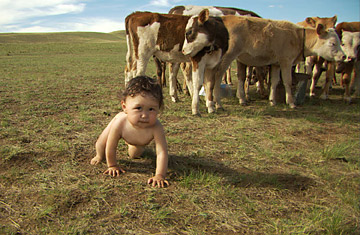
Bayarjargal, from Mongolia, is one of the four babies featured in Babies.
In the charming documentary Babies, French filmmaker Thomas Balmes presents us with a quartet of babies, infants freshly birthed in urban settings in Japan and America, as well as sun-baked Namibia and desolate Mongolia. Whether they are being babysat by a chicken or are attending a Mommy and Me yoga class, all the babies — three girls and one boy — come off much the same: cute, needy, feisty, curious little survivors making their way from womb to first uncertain steps. The film's message is loving and clear: we all created equal, even if some of us have better access to diapers.
There is no narration and all the sound is ambient. The cinematographers (one of whom is father to one of the subjects, Hattie from San Francisco) keep their cameras at baby level. Drama is limited to a mislaid toy, while suspense lies chiefly in seeing just how patient a cat or a dog can be with a human child (very). It's a lulling style of filmmaking, likely to produce a happy hypnosis on the parts of people who are already parents or wish to be someday. Others may go insane with boredom; this is not a date-night movie for George Clooney. Balmes smartly ends it at 80 minutes, right when the premise starts to wear thin for even the biggest baby fans.
What is on screen is less interesting the response Babies triggers in us the audience. Faced with the charming sameness of the pre-verbal, we reflect instead on the differences in the nurturing methods we witness. The babies may be served up like wildlife on Animal Planet, but this is our species, and thus we aren't just quietly fascinated; we're making at least some small judgments. (So are the filmmakers: having spent an average of 100 days following each child, they accordingly must have had many editing choices to make.) Would we ship our own children off to Mongolia to live? To Tokyo? Which child do we most want to rescue from his or her surroundings? (It's not necessarily the most impoverished.)
It is of course, foolish to make worldwide generalizations based on only four examples. But from a Western point of view, it's hard not to notice the relative ease and freedom from fuss that goes into life in the Third World with an infant. In Mongolia, the movie's lone boy, Bayarjarga, spends his earliest weeks wrapped up in a exquisite package with a practical purpose; no baby swaddled that tightly is going to roll off the bed while his mother is out milking a goat.
A Namibian mom shaves the head of her baby girl, the scrumptious Ponijao, with a knife, presumably to keep away heat or parasites. The mother's attentions are not unloving, but she gives off the air of someone engaged in a pleasantly mindless task, kind of like polishing one's shoes. She wipes away Ponijao's freefalling poop with a dried cornhusk and the same quiet efficiency. Ponijao is always surrounded by extended family, and when everyone is regally breastfeeding in tandem, the old "it takes a village" adage comes to mind (as does the old Playtex motto, "cross your heart" — life without support garments looks more painful than life without diapers).
Meanwhile, in the First World, babies are kept busy with organized activities, and we see a lot more of the fathers; in the Third World, presumably they are hunting, gathering or trying to brew beer. Mari, the Tokyo infant, sits on her father's lap while he works; in San Francisco, Hattie's dad brings her to a sing-a-long. Hattie seemed oblivious to the verse "The earth is our mother, she will take care of us" — no fault of hers; the melody was about as rousing as the lyrics — but I felt some chagrin on behalf of American parents, who seek out such insipid playtime and have no idea how to lovingly wield a knife on their babies' heads.
Now it may be that a Mongolian film critic reviewing Babies will say she is embarrassed about the way Mongolian infants are portrayed as unwitting victims of sibling sadism (Bayarjarga's brother repeatedly whacks him in the face while mom is out of the yurt). The movie may be a sweetly egalitarian enterprise, but undeniably, it invites social criticism; it wants us to compare and contrast based on our own lives. The impression I haven't shaken is the look on Hattie's mother's face when her baby hit her. It was the look of forced indulgence you wear when a friend or relative's child has just sassed or smacked you, conveying "I can't or shouldn't correct this inappropriate behavior, but I do hope it stops." Today, Hattie is probably in a much better preschool than Ponijao. But in the future the Namibian girl may have the advantage over the American in terms of one important thing. Having witnessed, firsthand, an instinctive, maternal confidence from her earliest days, she may someday find it easier to be a relaxed parent herself.
